Exploring Hyperglycemia: Blood Tests, Parameters, and Pathophysiology
VerifiedAdded on 2023/06/13
|6
|800
|379
Homework Assignment
AI Summary
This assignment solution provides a comprehensive overview of hyperglycemia, focusing on the blood tests used to assess its risk and existing conditions. It identifies the HbA1c test as the most frequently used, detailing its significance in measuring average blood sugar levels. The solution elaborates on the key parameters tested, including carbohydrates, lipids, and proteins, explaining the chemical reactions involved in their quantification and the physiological reasons for their testing. Furthermore, it includes a discussion on the pathophysiology of hyperglycemia, differentiating between type 1 and type 2 diabetes and their respective underlying mechanisms.

Running head: HYPERGLYCEMIA 1
Hyperglycemia
Name
Institution
Hyperglycemia
Name
Institution
Paraphrase This Document
Need a fresh take? Get an instant paraphrase of this document with our AI Paraphraser
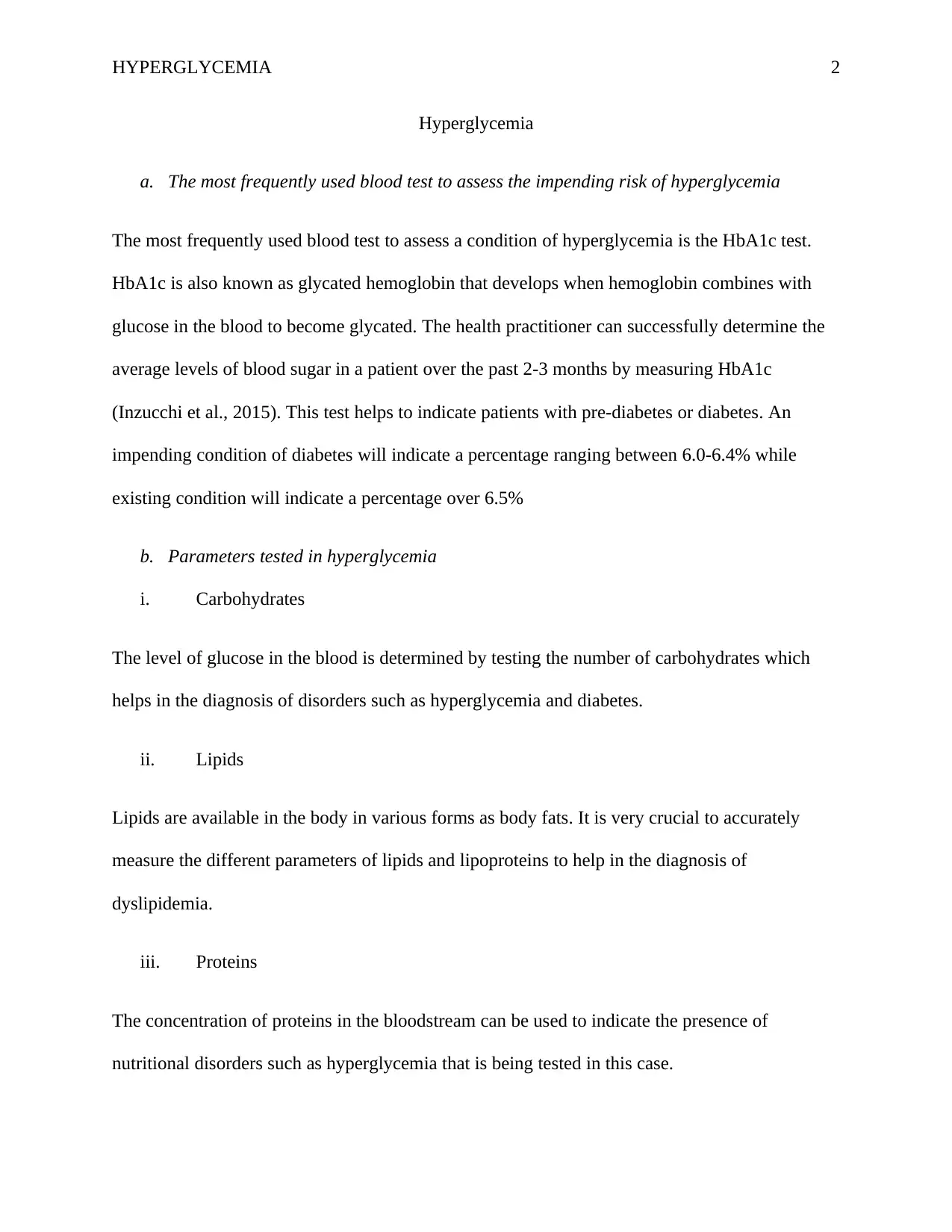
HYPERGLYCEMIA 2
Hyperglycemia
a. The most frequently used blood test to assess the impending risk of hyperglycemia
The most frequently used blood test to assess a condition of hyperglycemia is the HbA1c test.
HbA1c is also known as glycated hemoglobin that develops when hemoglobin combines with
glucose in the blood to become glycated. The health practitioner can successfully determine the
average levels of blood sugar in a patient over the past 2-3 months by measuring HbA1c
(Inzucchi et al., 2015). This test helps to indicate patients with pre-diabetes or diabetes. An
impending condition of diabetes will indicate a percentage ranging between 6.0-6.4% while
existing condition will indicate a percentage over 6.5%
b. Parameters tested in hyperglycemia
i. Carbohydrates
The level of glucose in the blood is determined by testing the number of carbohydrates which
helps in the diagnosis of disorders such as hyperglycemia and diabetes.
ii. Lipids
Lipids are available in the body in various forms as body fats. It is very crucial to accurately
measure the different parameters of lipids and lipoproteins to help in the diagnosis of
dyslipidemia.
iii. Proteins
The concentration of proteins in the bloodstream can be used to indicate the presence of
nutritional disorders such as hyperglycemia that is being tested in this case.
Hyperglycemia
a. The most frequently used blood test to assess the impending risk of hyperglycemia
The most frequently used blood test to assess a condition of hyperglycemia is the HbA1c test.
HbA1c is also known as glycated hemoglobin that develops when hemoglobin combines with
glucose in the blood to become glycated. The health practitioner can successfully determine the
average levels of blood sugar in a patient over the past 2-3 months by measuring HbA1c
(Inzucchi et al., 2015). This test helps to indicate patients with pre-diabetes or diabetes. An
impending condition of diabetes will indicate a percentage ranging between 6.0-6.4% while
existing condition will indicate a percentage over 6.5%
b. Parameters tested in hyperglycemia
i. Carbohydrates
The level of glucose in the blood is determined by testing the number of carbohydrates which
helps in the diagnosis of disorders such as hyperglycemia and diabetes.
ii. Lipids
Lipids are available in the body in various forms as body fats. It is very crucial to accurately
measure the different parameters of lipids and lipoproteins to help in the diagnosis of
dyslipidemia.
iii. Proteins
The concentration of proteins in the bloodstream can be used to indicate the presence of
nutritional disorders such as hyperglycemia that is being tested in this case.
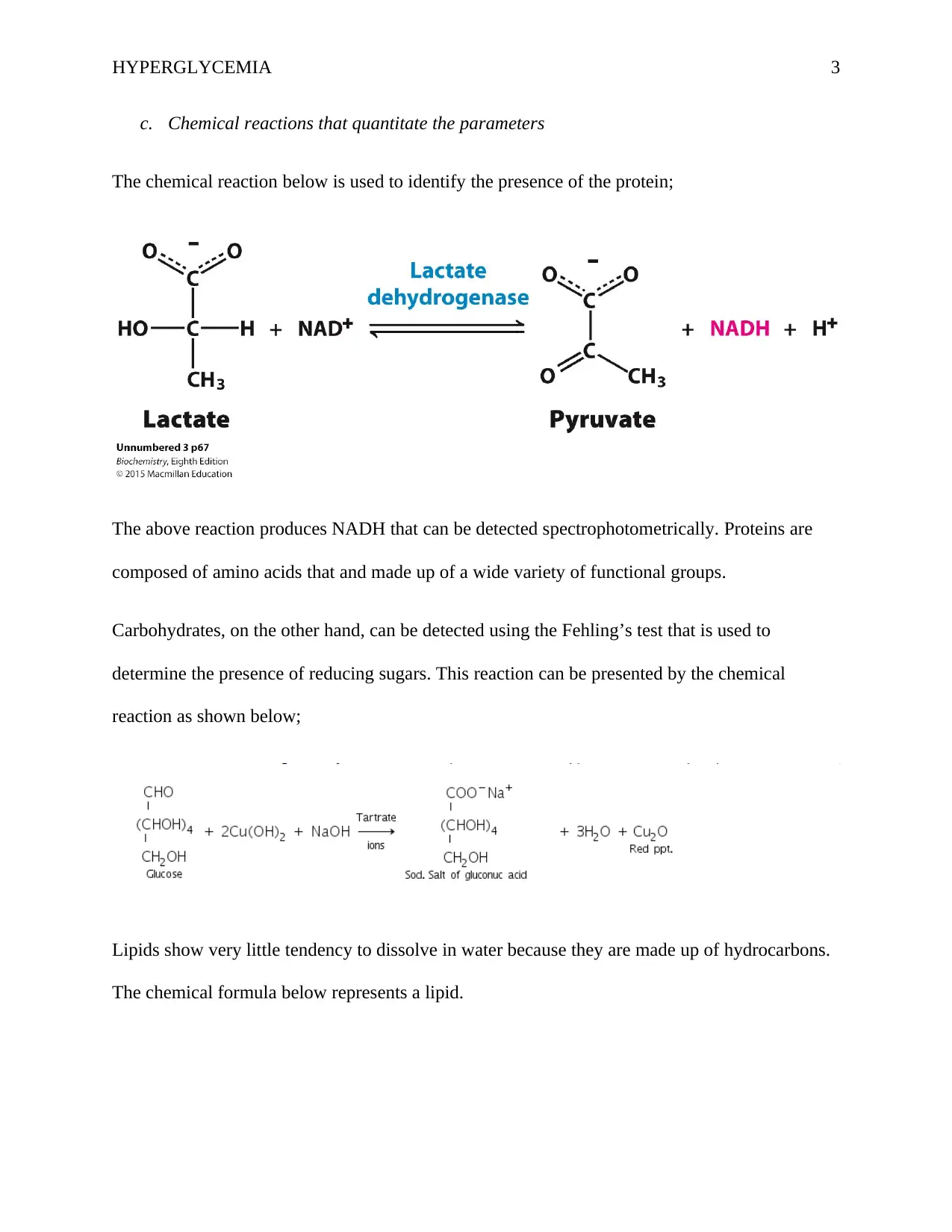
HYPERGLYCEMIA 3
c. Chemical reactions that quantitate the parameters
The chemical reaction below is used to identify the presence of the protein;
The above reaction produces NADH that can be detected spectrophotometrically. Proteins are
composed of amino acids that and made up of a wide variety of functional groups.
Carbohydrates, on the other hand, can be detected using the Fehling’s test that is used to
determine the presence of reducing sugars. This reaction can be presented by the chemical
reaction as shown below;
Lipids show very little tendency to dissolve in water because they are made up of hydrocarbons.
The chemical formula below represents a lipid.
c. Chemical reactions that quantitate the parameters
The chemical reaction below is used to identify the presence of the protein;
The above reaction produces NADH that can be detected spectrophotometrically. Proteins are
composed of amino acids that and made up of a wide variety of functional groups.
Carbohydrates, on the other hand, can be detected using the Fehling’s test that is used to
determine the presence of reducing sugars. This reaction can be presented by the chemical
reaction as shown below;
Lipids show very little tendency to dissolve in water because they are made up of hydrocarbons.
The chemical formula below represents a lipid.
⊘ This is a preview!⊘
Do you want full access?
Subscribe today to unlock all pages.

Trusted by 1+ million students worldwide
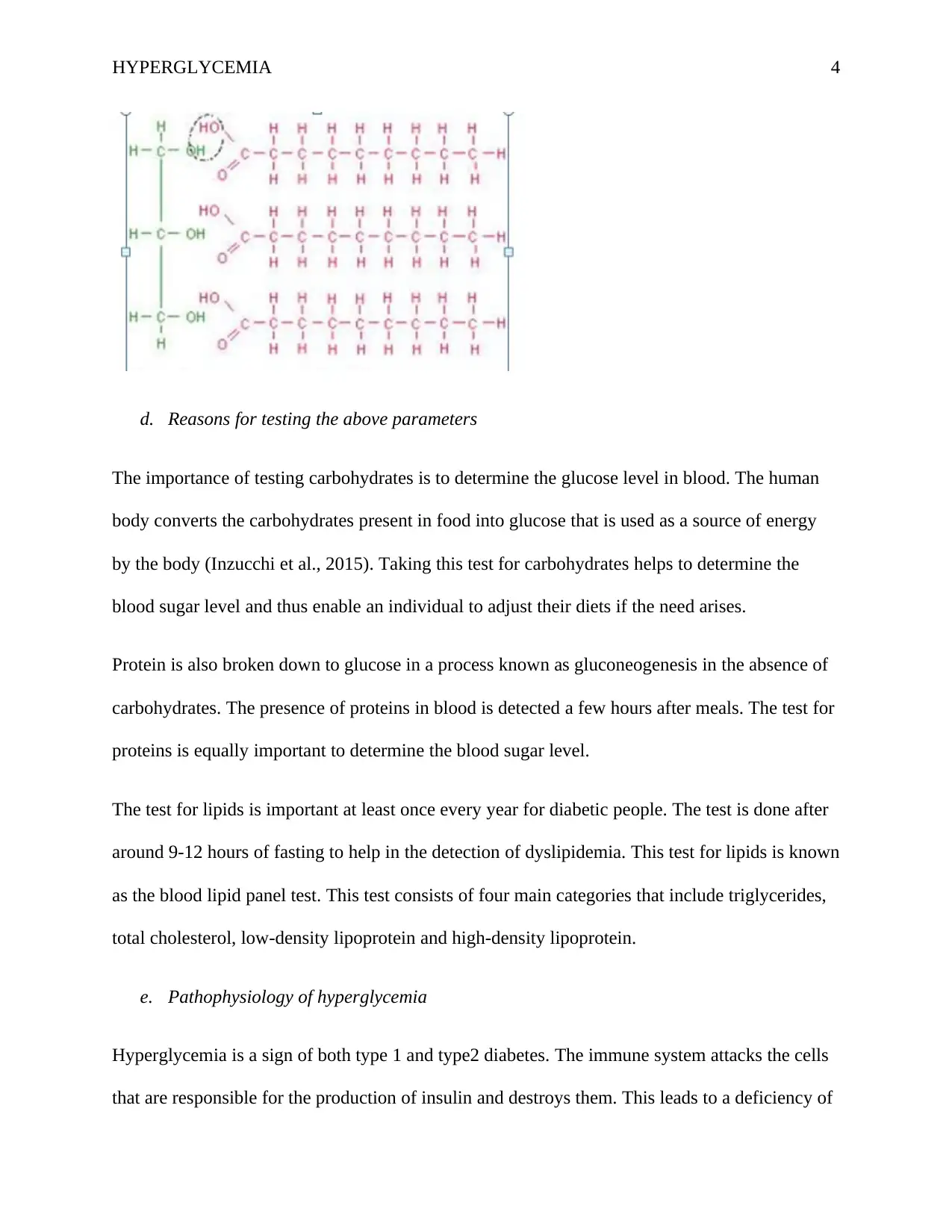
HYPERGLYCEMIA 4
d. Reasons for testing the above parameters
The importance of testing carbohydrates is to determine the glucose level in blood. The human
body converts the carbohydrates present in food into glucose that is used as a source of energy
by the body (Inzucchi et al., 2015). Taking this test for carbohydrates helps to determine the
blood sugar level and thus enable an individual to adjust their diets if the need arises.
Protein is also broken down to glucose in a process known as gluconeogenesis in the absence of
carbohydrates. The presence of proteins in blood is detected a few hours after meals. The test for
proteins is equally important to determine the blood sugar level.
The test for lipids is important at least once every year for diabetic people. The test is done after
around 9-12 hours of fasting to help in the detection of dyslipidemia. This test for lipids is known
as the blood lipid panel test. This test consists of four main categories that include triglycerides,
total cholesterol, low-density lipoprotein and high-density lipoprotein.
e. Pathophysiology of hyperglycemia
Hyperglycemia is a sign of both type 1 and type2 diabetes. The immune system attacks the cells
that are responsible for the production of insulin and destroys them. This leads to a deficiency of
d. Reasons for testing the above parameters
The importance of testing carbohydrates is to determine the glucose level in blood. The human
body converts the carbohydrates present in food into glucose that is used as a source of energy
by the body (Inzucchi et al., 2015). Taking this test for carbohydrates helps to determine the
blood sugar level and thus enable an individual to adjust their diets if the need arises.
Protein is also broken down to glucose in a process known as gluconeogenesis in the absence of
carbohydrates. The presence of proteins in blood is detected a few hours after meals. The test for
proteins is equally important to determine the blood sugar level.
The test for lipids is important at least once every year for diabetic people. The test is done after
around 9-12 hours of fasting to help in the detection of dyslipidemia. This test for lipids is known
as the blood lipid panel test. This test consists of four main categories that include triglycerides,
total cholesterol, low-density lipoprotein and high-density lipoprotein.
e. Pathophysiology of hyperglycemia
Hyperglycemia is a sign of both type 1 and type2 diabetes. The immune system attacks the cells
that are responsible for the production of insulin and destroys them. This leads to a deficiency of
Paraphrase This Document
Need a fresh take? Get an instant paraphrase of this document with our AI Paraphraser
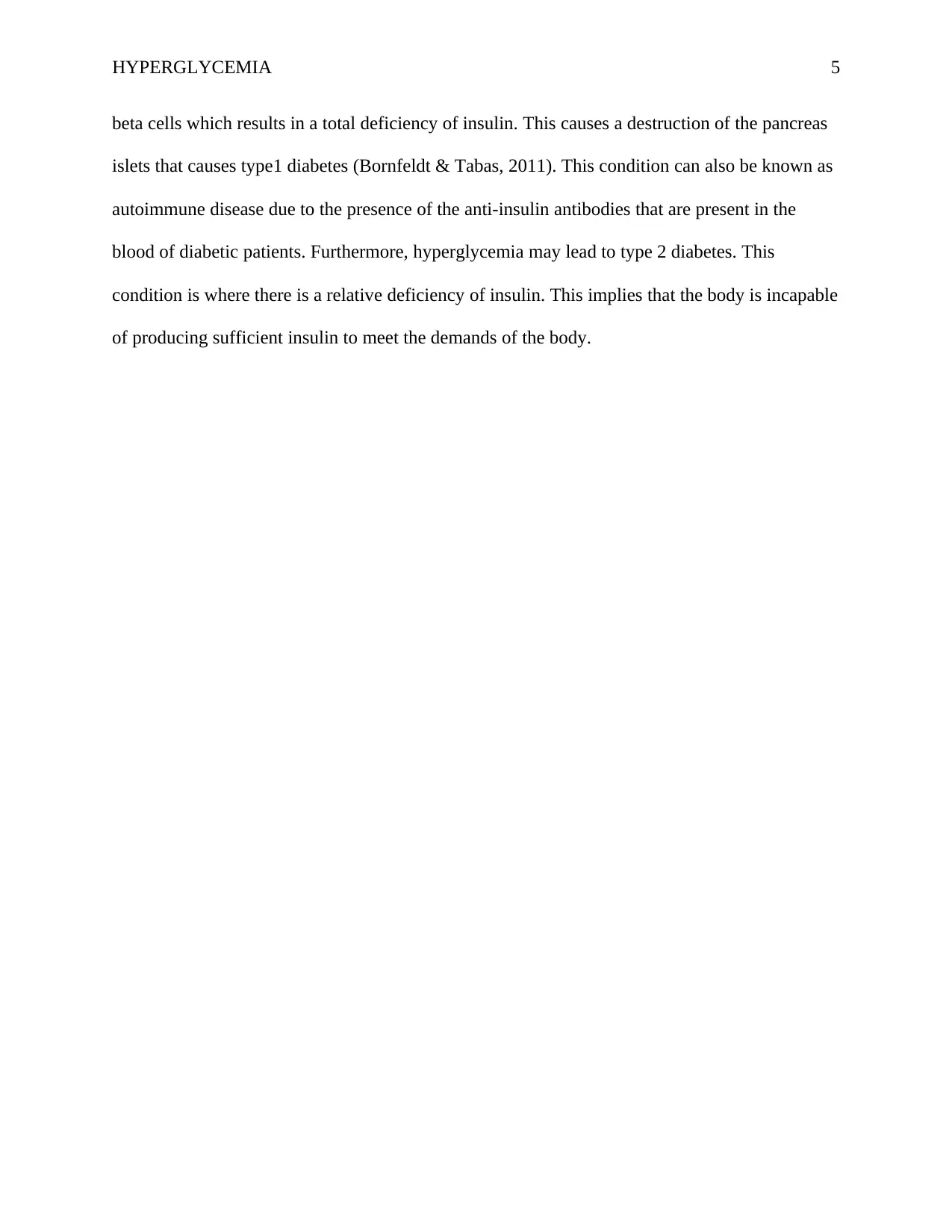
HYPERGLYCEMIA 5
beta cells which results in a total deficiency of insulin. This causes a destruction of the pancreas
islets that causes type1 diabetes (Bornfeldt & Tabas, 2011). This condition can also be known as
autoimmune disease due to the presence of the anti-insulin antibodies that are present in the
blood of diabetic patients. Furthermore, hyperglycemia may lead to type 2 diabetes. This
condition is where there is a relative deficiency of insulin. This implies that the body is incapable
of producing sufficient insulin to meet the demands of the body.
beta cells which results in a total deficiency of insulin. This causes a destruction of the pancreas
islets that causes type1 diabetes (Bornfeldt & Tabas, 2011). This condition can also be known as
autoimmune disease due to the presence of the anti-insulin antibodies that are present in the
blood of diabetic patients. Furthermore, hyperglycemia may lead to type 2 diabetes. This
condition is where there is a relative deficiency of insulin. This implies that the body is incapable
of producing sufficient insulin to meet the demands of the body.
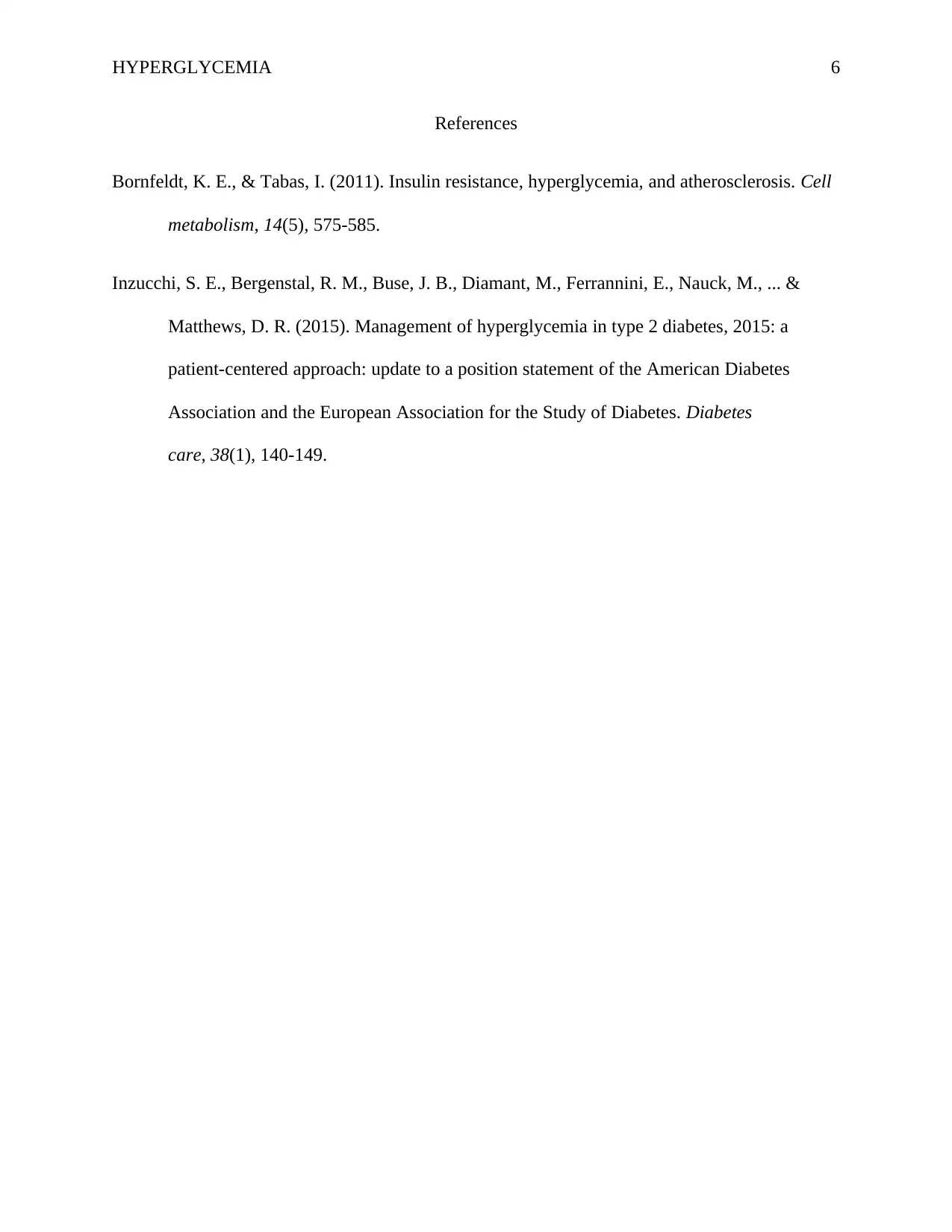
HYPERGLYCEMIA 6
References
Bornfeldt, K. E., & Tabas, I. (2011). Insulin resistance, hyperglycemia, and atherosclerosis. Cell
metabolism, 14(5), 575-585.
Inzucchi, S. E., Bergenstal, R. M., Buse, J. B., Diamant, M., Ferrannini, E., Nauck, M., ... &
Matthews, D. R. (2015). Management of hyperglycemia in type 2 diabetes, 2015: a
patient-centered approach: update to a position statement of the American Diabetes
Association and the European Association for the Study of Diabetes. Diabetes
care, 38(1), 140-149.
References
Bornfeldt, K. E., & Tabas, I. (2011). Insulin resistance, hyperglycemia, and atherosclerosis. Cell
metabolism, 14(5), 575-585.
Inzucchi, S. E., Bergenstal, R. M., Buse, J. B., Diamant, M., Ferrannini, E., Nauck, M., ... &
Matthews, D. R. (2015). Management of hyperglycemia in type 2 diabetes, 2015: a
patient-centered approach: update to a position statement of the American Diabetes
Association and the European Association for the Study of Diabetes. Diabetes
care, 38(1), 140-149.
⊘ This is a preview!⊘
Do you want full access?
Subscribe today to unlock all pages.

Trusted by 1+ million students worldwide
1 out of 6
Related Documents
Your All-in-One AI-Powered Toolkit for Academic Success.
+13062052269
info@desklib.com
Available 24*7 on WhatsApp / Email
![[object Object]](/_next/static/media/star-bottom.7253800d.svg)
Unlock your academic potential
Copyright © 2020–2025 A2Z Services. All Rights Reserved. Developed and managed by ZUCOL.




